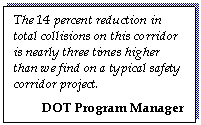U.S. Department of Transportation
Federal Highway Administration
1200 New Jersey Avenue, SE
Washington, DC 20590
202-366-4000
| < Previous | Table of Contents | Next > |
Multidisciplinary approaches can be used to improve safety along designated corridors which many states are implementing. In one state, the program began in 1992. Since that time, 32 projects have been launched and 27 completed. Corridor selection criteria include: statistical evidence (established by the state DOT) that a section or set of roadways is experiencing a significant crash problem, local-level support, and low-cost, near-term solutions.
The goal of the corridor safety program is to reduce fatal and disabling collisions on roadways through partnerships with community groups, businesses, engineering, enforcement, education, and emergency services organizations. The safety corridor programs are implemented at the community level.
The state’s most noteworthy corridor program encompassed seven miles of roadway located within one city’s boundaries. The program’s steering committee was comprised of local government agencies, law enforcement officials, emergency response personnel, school districts, and other interested parties.
 Project funding provided increased traffic patrols focused on crosswalk safety, driving under the influence (DUI) of alcohol or drugs, and red light running. The police department reported 4,147 contacts, 2,539 citations, 149 suspended or miscellaneous criminal violations; 44 DUI arrests, 35 warrant arrests, and 1,667 verbal warnings. (Note: warnings plus infractions is slightly higher than total contacts because some drivers were cited for multiple violations).
Project funding provided increased traffic patrols focused on crosswalk safety, driving under the influence (DUI) of alcohol or drugs, and red light running. The police department reported 4,147 contacts, 2,539 citations, 149 suspended or miscellaneous criminal violations; 44 DUI arrests, 35 warrant arrests, and 1,667 verbal warnings. (Note: warnings plus infractions is slightly higher than total contacts because some drivers were cited for multiple violations).
The engineering team completed several low-cost, near-term improvements to the corridor, including installation of signs to mark the corridor, improved timing, and upgrades to traffic signals and crosswalks, installation of pedestrian warning lights, and bus stop upgrades.
During the project, steering committee members educated the public by hosting a traffic safety fair, making pedestrian safety presentations to area elementary and middle school students, utilizing transit advertising, and distributing pedestrian safety information brochures in English, Spanish, and Russian to residents and businesses.
 Results of the two-year effort showed a 19 percent drop in fatal/disabling and injury collisions and a 14 percent decrease in total collisions. Rear end collisions, which were the leading type of collision in the corridor, decreased 10 percent, while drivers failing to yield decreased 44 percent.
Results of the two-year effort showed a 19 percent drop in fatal/disabling and injury collisions and a 14 percent decrease in total collisions. Rear end collisions, which were the leading type of collision in the corridor, decreased 10 percent, while drivers failing to yield decreased 44 percent.
| < Previous | Table of Contents | Next > |
